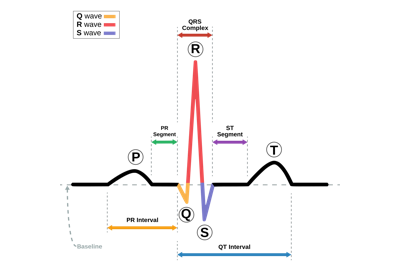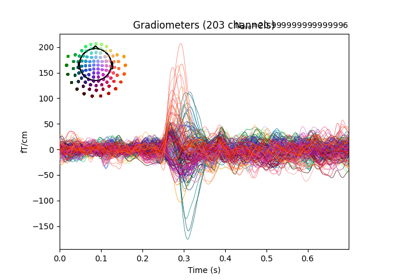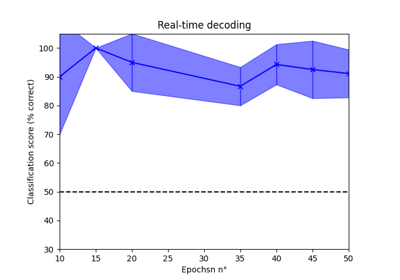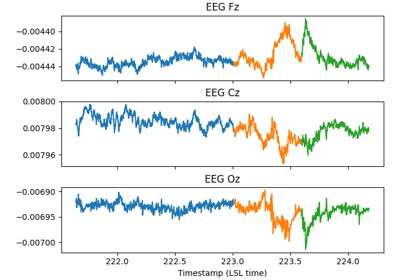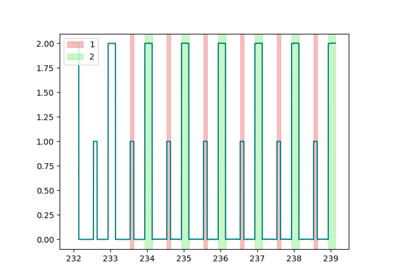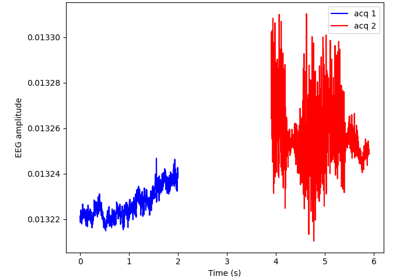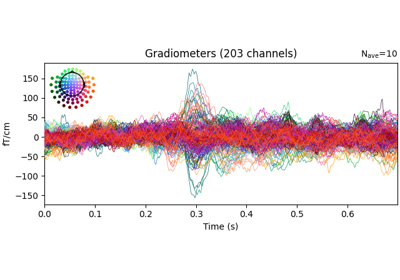mne_lsl.stream.BaseStream🔗
- class mne_lsl.stream.BaseStream(bufsize)[source]🔗
Stream object representing a single real-time stream.
- Parameters:
- bufsize
float|int Size of the buffer keeping track of the data received from the stream. If the stream sampling rate
sfreqis regular,bufsizeis expressed in seconds. The buffer will hold the lastbufsize * sfreqsamples (ceiled). If the stream sampling ratesfreqis irregular,bufsizeis expressed in samples. The buffer will hold the lastbufsizesamples.
- bufsize
Attributes
List of callbacks to be called when new data is available.
Name of the channels.
The current gradient compensation grade.
Connection status of the stream.
Channel format of the stream.
List of filters applied to the real-time Stream.
Info of the LSL stream.
Number of samples that can be stored in the buffer.
Number of new samples available in the buffer.
Methods
acquire()Pull new samples in the internal circular buffer.
add_callback(callback)Add a callback to the stream.
add_reference_channels(ref_channels[, ref_units])Add EEG reference channels to data that consists of all zeros.
anonymize([daysback, keep_his, verbose])Anonymize the measurement information in-place.
connect(acquisition_delay)Connect to the stream and initiate data collection in the buffer.
connect_hpi_stream(hpi_stream[, format])Connect to a stream that provides HPI data.
del_filter([idx])Remove a filter from the list of applied filters.
Disconnect from the LSL stream and interrupt data collection.
drop_channels(ch_names)Drop channel(s).
filter(l_freq, h_freq[, picks, iir_params, ...])Filter the stream with an IIR causal filter.
get_channel_types([picks, unique, only_data_chs])Get a list of channel type for each channel.
get_channel_units([picks, only_data_chs])Get a list of channel unit for each channel.
get_data([winsize, picks, exclude])Retrieve the latest data from the buffer.
Get a DigMontage from instance.
notch_filter(freqs[, picks, notch_widths, ...])Filter the stream with an IIR causal notch filter.
pick([picks, exclude])Pick a subset of channels.
plot()Open a real-time stream viewer.
plot_sensors([kind, ch_type, title, ...])Plot sensor positions.
record()Record the stream data to disk.
rename_channels(mapping[, allow_duplicates, ...])Rename channels.
Set a bipolar reference.
set_channel_types(mapping, *[, ...])Define the sensor type of channels.
set_channel_units(mapping)Define the channel unit multiplication factor.
set_eeg_reference(ref_channels[, ch_type])Specify which reference to use for EEG-like data.
set_meas_date(meas_date)Set the measurement start date.
set_montage(montage[, match_case, ...])Set EEG/sEEG/ECoG/DBS/fNIRS channel positions and digitization points.
- abstractmethod acquire()[source]🔗
Pull new samples in the internal circular buffer.
Notes
This method is not needed if the stream was connected with an acquisition delay different from
0. In this case, the acquisition is done automatically in a background thread.
- add_callback(callback)[source]🔗
Add a callback to the stream.
- Parameters:
- callback
Callable A callable function called on each new acquire window. The callback operates on a data array of shape
(n_times, n_channels)(and its timestamps) and is called after:applying channel selection defined through
pickanddrop_channels.adding channels defined through
add_reference_channels.applying EEG reference defined through
set_eeg_reference.applying filters defined through
filterandnotch_filter.
Thus, the callback signature should be:
def callback( data: NDArray[...], timestamps: NDArray[np.float64], info: mne.Info ) -> tuple[NDArray[...], NDArray[np.float64]]: """A callback function. Parameters ---------- data : NDArray[...] Data array of shape (n_times, n_channels). timestamps : NDArray[np.float64] Timestamp array of shape (n_times,). info : Info MNE Info object containing the metadata about the stream. Returns ------- data : NDArray[...] The modified data array of shape (n_times, n_channels). timestamps : NDArray[np.float64] The modified timestamp array of shape (n_times,). """ # implement your callback function here and return the modified data and timestamps return data, timestamps
With
datais the data array of shape(n_times, n_channels)and ofdtypedefined in the stream;timestampsis the timestamp array of shape(n_times,)anddtypeofnp.float64, andinfois the stream information.Note
Ideally, the callback should modify the data in place.
- callback
- Returns:
- streaminstance of
Stream The stream instance modified in-place.
- streaminstance of
Notes
Callback(s) are called in the same thread as the acquisition. Thus, they should be fast and non-blocking. If the callback takes too long, the acquisition will be delayed.
Callback(s) are called in the order they were added. The callback is called whenever new data is available in the buffer.
Callback(s) are removed when the stream is disconnected.
- add_reference_channels(ref_channels, ref_units=None)[source]🔗
Add EEG reference channels to data that consists of all zeros.
Adds EEG reference channels that are not part of the streamed data. This is useful when you need to re-reference your data to different channels. These added channels will consist of all zeros.
- Parameters:
- ref_channels
str|listofstr Name of the electrode(s) which served as the reference in the recording. If a name is provided, a corresponding channel is added and its data is set to 0. This is useful for later re-referencing.
- ref_units
str|int|listofstr|listofint|None The unit or unit multiplication factor of the reference channels. The unit can be given as a human-readable string or as a unit multiplication factor, e.g.
-6for microvolts corresponding to1e-6. If not provided, the added EEG reference channel has a unit multiplication factor set to0which corresponds to Volts. UseStream.set_channel_unitsto change the unit multiplication factor.
- ref_channels
- Returns:
- streaminstance of
Stream The stream instance modified in-place.
- streaminstance of
Notes
Read about the processing applied to the underlying buffer.
- anonymize(daysback=None, keep_his=False, *, verbose=None)[source]🔗
Anonymize the measurement information in-place.
- Parameters:
- daysback
int|None Number of days to subtract from all dates. If
None(default), the acquisition date,info['meas_date'], will be set toJanuary 1ˢᵗ, 2000. This parameter is ignored ifinfo['meas_date']isNone(i.e., no acquisition date has been set).- keep_his
bool If
True,his_idofsubject_infowill not be overwritten. Defaults toFalse.Warning
This could mean that
infois not fully anonymized. Use with caution.- verbose
int|str|bool|None Sets the verbosity level. The verbosity increases gradually between
"CRITICAL","ERROR","WARNING","INFO"and"DEBUG". If None is provided, the verbosity is set to the currently set logger’s level. If a bool is provided, the verbosity is set to"WARNING"for False and to"INFO"for True.
- daysback
- Returns:
- streaminstance of
Stream The stream instance modified in-place.
- streaminstance of
Notes
Removes potentially identifying information if it exists in
info. Specifically for each of the following we use:- meas_date, file_id, meas_id
A default value, or as specified by
daysback.
- subject_info
Default values, except for ‘birthday’ which is adjusted to maintain the subject age.
- experimenter, proj_name, description
Default strings.
- utc_offset
None.
- proj_id
Zeros.
- proc_history
Dates use the
meas_datelogic, and experimenter a default string.
- helium_info, device_info
Dates use the
meas_datelogic, meta info uses defaults.
If
info['meas_date']isNone, it will remainNoneduring processing the above fields.Operates in place.
- abstractmethod connect(acquisition_delay)[source]🔗
Connect to the stream and initiate data collection in the buffer.
- Parameters:
- Returns:
- streaminstance of
Stream The stream instance modified in-place.
- streaminstance of
- connect_hpi_stream(hpi_stream, format='megin')[source]🔗
Connect to a stream that provides HPI data.
The HPI data will automatically update in the background the
dev_head_t.- Parameters:
- hpi_streaminstance of
Stream The stream to connect to containing the HPI data in the right format.
- format
str The format of the HPI data. Currently, only
"megin"is supported.
- hpi_streaminstance of
- Returns:
- streaminstance of
Stream The stream instance modified in-place.
- streaminstance of
Notes
meginformat: the applicationneuromag2lslprovides a second HPI stream irregularly sampled where each sample contains the HPI data in the format of a vector of shape (12,) containing the 4x4 transformation matrix:R11 R12 R13 T1 R21 R22 R23 T2 R31 R32 R33 T3 0 0 0 1
- del_filter(idx='all')[source]🔗
Remove a filter from the list of applied filters.
- Parameters:
Notes
When removing a filter, the initial conditions of all the filters applied on overlapping channels are reset. The initial conditions will be re-estimated as a step response steady-state.
- abstractmethod disconnect()[source]🔗
Disconnect from the LSL stream and interrupt data collection.
- Returns:
- streaminstance of
Stream The stream instance modified in-place.
- streaminstance of
- drop_channels(ch_names)[source]🔗
Drop channel(s).
- Parameters:
- Returns:
- streaminstance of
Stream The stream instance modified in-place.
- streaminstance of
See also
- filter(l_freq, h_freq, picks=None, iir_params=None, *, verbose=None)[source]🔗
Filter the stream with an IIR causal filter.
Once a filter is applied, the buffer is updated in real-time with the filtered data. It is possible to apply more than one filter.
stream = Stream(2.0).connect() stream.filter(1.0, 40.0, picks="eeg") stream.filter(1.0, 15.0, picks="ecg").filter(0.1, 5, picks="EDA")
- Parameters:
- l_freq
float|None The lower cutoff frequency. If None, the buffer is only low-passed.
- h_freq
float|None The higher cutoff frequency. If None, the buffer is only high-passed.
- picks
str| array_like |slice|None Channels to include. Slices and lists of integers will be interpreted as channel indices. In lists, channel type strings (e.g.,
['meg', 'eeg']) will pick channels of those types, channel name strings (e.g.,['MEG0111', 'MEG2623']will pick the given channels. Can also be the string values'all'to pick all channels, or'data'to pick data channels. None (default) will pick all channels. Note that channels ininfo['bads']will be included if their names or indices are explicitly provided.- iir_params
dict|None Dictionary of parameters to use for IIR filtering. If None, a 4th order Butterworth will be used. For more information, see
mne.filter.construct_iir_filter().Note
The output
sosmust be used. Thebaoutput is not supported.- verbose
int|str|bool|None Sets the verbosity level. The verbosity increases gradually between
"CRITICAL","ERROR","WARNING","INFO"and"DEBUG". If None is provided, the verbosity is set to the currently set logger’s level. If a bool is provided, the verbosity is set to"WARNING"for False and to"INFO"for True.
- l_freq
- Returns:
- streaminstance of
Stream The stream instance modified in-place.
- streaminstance of
Notes
Read about the processing applied to the underlying buffer.
- get_channel_types(picks=None, unique=False, only_data_chs=False)[source]🔗
Get a list of channel type for each channel.
- Parameters:
- picks
str| array_like |slice|None Channels to include. Slices and lists of integers will be interpreted as channel indices. In lists, channel type strings (e.g.,
['meg', 'eeg']) will pick channels of those types, channel name strings (e.g.,['MEG0111', 'MEG2623']will pick the given channels. Can also be the string values'all'to pick all channels, or'data'to pick data channels. None (default) will pick all channels. Note that channels ininfo['bads']will be included if their names or indices are explicitly provided.- unique
bool Whether to return only unique channel types. Default is
False.- only_data_chs
bool Whether to ignore non-data channels. Default is
False.
- picks
- Returns:
- channel_types
list The channel types.
- channel_types
- get_channel_units(picks=None, only_data_chs=False)[source]🔗
Get a list of channel unit for each channel.
- Parameters:
- picks
str| array_like |slice|None Channels to include. Slices and lists of integers will be interpreted as channel indices. In lists, channel type strings (e.g.,
['meg', 'eeg']) will pick channels of those types, channel name strings (e.g.,['MEG0111', 'MEG2623']will pick the given channels. Can also be the string values'all'to pick all channels, or'data'to pick data channels. None (default) will pick all channels. Note that channels ininfo['bads']will be included if their names or indices are explicitly provided.- only_data_chs
bool Whether to ignore non-data channels. Default is
False.
- picks
- Returns:
- get_data(winsize=None, picks=None, exclude='bads')[source]🔗
Retrieve the latest data from the buffer.
- Parameters:
- winsize
float|int|None Size of the window of data to view. If the stream sampling rate
sfreqis regular,winsizeis expressed in seconds. The window will view the lastwinsize * sfreqsamples (ceiled) from the buffer. If the stream sampling sampling ratesfreqis irregular,winsizeis expressed in samples. The window will view the lastwinsizesamples. IfNone, the entire buffer is returned.- picks
str| array_like |slice|None Channels to include. Slices and lists of integers will be interpreted as channel indices. In lists, channel type strings (e.g.,
['meg', 'eeg']) will pick channels of those types, channel name strings (e.g.,['MEG0111', 'MEG2623']will pick the given channels. Can also be the string values'all'to pick all channels, or'data'to pick data channels. None (default) will pick all channels. Note that channels ininfo['bads']will be included if their names or indices are explicitly provided.- exclude
str|listofstr|tupleofstr Set of channels to exclude, only used when picking based on types (e.g.,
exclude="bads"whenpicks="meg") or when picking is set toNone.
- winsize
- Returns:
Notes
The number of newly available samples stored in the property
n_new_samplesis reset at every function call, even if all channels were not selected with the argumentpicks.
- get_montage()[source]🔗
Get a DigMontage from instance.
- Returns:
- montage
None|DigMontage A copy of the channel positions, if available, otherwise
None.
- montage
- notch_filter(freqs, picks=None, notch_widths=None, trans_bandwidth=1, iir_params=None, *, verbose=None)[source]🔗
Filter the stream with an IIR causal notch filter.
Once a filter is applied, the buffer is updated in real-time with the filtered data. It is possible to apply more than one filter.
stream = Stream(2.0).connect() stream.filter(1.0, 40.0, picks="eeg") stream.notch_filter(50, picks="ecg")
- Parameters:
- freqs
float Specific frequencies to filter out from data, e.g.
60Hz in the US or50Hz in Europe for line noise.- picks
str| array_like |slice|None Channels to include. Slices and lists of integers will be interpreted as channel indices. In lists, channel type strings (e.g.,
['meg', 'eeg']) will pick channels of those types, channel name strings (e.g.,['MEG0111', 'MEG2623']will pick the given channels. Can also be the string values'all'to pick all channels, or'data'to pick data channels. None (default) will pick all channels. Note that channels ininfo['bads']will be included if their names or indices are explicitly provided.- notch_widths
float|None Width of the stop band in Hz. If
None,freqs / 200is used.- trans_bandwidth
float Width of the transition band in Hz.
- iir_params
dict|None Dictionary of parameters to use for IIR filtering. If None, a 4th order Butterworth will be used. For more information, see
mne.filter.construct_iir_filter().Note
The output
sosmust be used. Thebaoutput is not supported.- verbose
int|str|bool|None Sets the verbosity level. The verbosity increases gradually between
"CRITICAL","ERROR","WARNING","INFO"and"DEBUG". If None is provided, the verbosity is set to the currently set logger’s level. If a bool is provided, the verbosity is set to"WARNING"for False and to"INFO"for True.
- freqs
- Returns:
- streaminstance of
Stream The stream instance modified in-place.
- streaminstance of
Notes
Read about the processing applied to the underlying buffer.
- pick(picks=None, exclude=())[source]🔗
Pick a subset of channels.
- Parameters:
- picks
str| array_like |slice|None Channels to include. Slices and lists of integers will be interpreted as channel indices. In lists, channel type strings (e.g.,
['meg', 'eeg']) will pick channels of those types, channel name strings (e.g.,['MEG0111', 'MEG2623']will pick the given channels. Can also be the string values'all'to pick all channels, or'data'to pick data channels. None (default) will pick all channels.- exclude
str|listofstr Set of channels to exclude, only used when picking is based on types, e.g.
exclude='bads'whenpicks="meg".
- picks
- Returns:
- streaminstance of
Stream The stream instance modified in-place.
- streaminstance of
See also
Notes
Contrary to MNE-Python, re-ordering channels is not supported in
MNE-LSL. Thus, if explicit channel names are provided inpicks, they are sorted to match the order of existing channel names.
- plot_sensors(kind='topomap', ch_type=None, title=None, show_names=False, ch_groups=None, to_sphere=True, axes=None, block=False, show=True, sphere=None, *, verbose=None)[source]🔗
Plot sensor positions.
- Parameters:
- kind
str Whether to plot the sensors as 3d, topomap or as an interactive sensor selection dialog. Available options ‘topomap’, ‘3d’, ‘select’. If ‘select’, a set of channels can be selected interactively by using lasso selector or clicking while holding control key. The selected channels are returned along with the figure instance. Defaults to ‘topomap’.
- ch_type
None|str The channel type to plot. Available options
'mag','grad','eeg','seeg','dbs','ecog','all'. If'all', all the available mag, grad, eeg, seeg, dbs, and ecog channels are plotted. If None (default), then channels are chosen in the order given above.- title
str|None Title for the figure. If None (default), equals to
'Sensor positions (%s)' % ch_type.- show_names
bool|arrayofstr Whether to display all channel names. If an array, only the channel names in the array are shown. Defaults to False.
- ch_groups‘position’ |
arrayof shape (n_ch_groups, n_picks) |None Channel groups for coloring the sensors. If None (default), default coloring scheme is used. If ‘position’, the sensors are divided into 8 regions. See
orderkwarg ofmne.viz.plot_raw(). If array, the channels are divided by picks given in the array.Added in version 0.13.0.
- to_sphere
bool Whether to project the 3d locations to a sphere. When False, the sensor array appears similar as to looking downwards straight above the subject’s head. Has no effect when kind=’3d’. Defaults to True.
Added in version 0.14.0.
- axesinstance of
Axes| instance ofAxes3D|None Axes to draw the sensors to. If
kind='3d', axes must be an instance of Axes3D. If None (default), a new axes will be created.Added in version 0.13.0.
- block
bool Whether to halt program execution until the figure is closed. Defaults to False.
Added in version 0.13.0.
- show
bool Show figure if True. Defaults to True.
- sphere
float| array_like | instance ofConductorModel|None| ‘auto’ | ‘eeglab’ The sphere parameters to use for the head outline. Can be array-like of shape (4,) to give the X/Y/Z origin and radius in meters, or a single float to give just the radius (origin assumed 0, 0, 0). Can also be an instance of a spherical
ConductorModelto use the origin and radius from that object. If'auto'the sphere is fit to digitization points. If'eeglab'the head circle is defined by EEG electrodes'Fpz','Oz','T7', and'T8'(if'Fpz'is not present, it will be approximated from the coordinates of'Oz').None(the default) is equivalent to'auto'when enough extra digitization points are available, and (0, 0, 0, 0.095) otherwise.Added in version 0.20.
Changed in version 1.1: Added
'eeglab'option.- verbose
bool|str|int|None Control verbosity of the logging output. If
None, use the default verbosity level. See the logging documentation andmne.verbose()for details. Should only be passed as a keyword argument.
- kind
- Returns:
See also
Notes
This function plots the sensor locations from the info structure using matplotlib. For drawing the sensors using PyVista see
mne.viz.plot_alignment().Added in version 0.12.0.
- rename_channels(mapping, allow_duplicates=False, *, verbose=None)[source]🔗
Rename channels.
- Parameters:
- mapping
dict|callable() A dictionary mapping the old channel to a new channel name e.g.
{'EEG061' : 'EEG161'}. Can also be a callable function that takes and returns a string.- allow_duplicates
bool If True (default False), allow duplicates, which will automatically be renamed with
-Nat the end.- verbose
int|str|bool|None Sets the verbosity level. The verbosity increases gradually between
"CRITICAL","ERROR","WARNING","INFO"and"DEBUG". If None is provided, the verbosity is set to the currently set logger’s level. If a bool is provided, the verbosity is set to"WARNING"for False and to"INFO"for True.
- mapping
- Returns:
- streaminstance of
Stream The stream instance modified in-place.
- streaminstance of
- set_bipolar_reference()[source]🔗
Set a bipolar reference. Not implemented.
- Returns:
- streaminstance of
Stream The stream instance modified in-place.
- streaminstance of
- set_channel_types(mapping, *, on_unit_change='warn', verbose=None)[source]🔗
Define the sensor type of channels.
If the new channel type changes the unit type, e.g. from
T/mtoV, the unit multiplication factor is reset to0. UseStream.set_channel_unitsto change the multiplication factor, e.g. from0to-6to change from Volts to microvolts.- Parameters:
- mapping
dict A dictionary mapping a channel to a sensor type (str), e.g.,
{'EEG061': 'eog'}or{'EEG061': 'eog', 'TRIGGER': 'stim'}.- on_unit_change
'raise'|'warn'|'ignore' What to do if the measurement unit of a channel is changed automatically to match the new sensor type.
Added in version MNE: 1.4
- verbose
int|str|bool|None Sets the verbosity level. The verbosity increases gradually between
"CRITICAL","ERROR","WARNING","INFO"and"DEBUG". If None is provided, the verbosity is set to the currently set logger’s level. If a bool is provided, the verbosity is set to"WARNING"for False and to"INFO"for True.
- mapping
- Returns:
- streaminstance of
Stream The stream instance modified in-place.
- streaminstance of
- set_channel_units(mapping)[source]🔗
Define the channel unit multiplication factor.
The unit itself is defined by the sensor type. Use
Stream.set_channel_typesto change the channel type, e.g. from planar gradiometers inT/mto EEG inV.- Parameters:
- mapping
dict A dictionary mapping a channel to a unit, e.g.
{'EEG061': 'microvolts'}. The unit can be given as a human-readable string or as a unit multiplication factor, e.g.-6for microvolts corresponding to1e-6.
- mapping
- Returns:
- streaminstance of
Stream The stream instance modified in-place.
- streaminstance of
Notes
If the human-readable unit of your channel is not yet supported by MNE-LSL, please contact the developers on GitHub to add your units to the known set.
- set_eeg_reference(ref_channels, ch_type='eeg')[source]🔗
Specify which reference to use for EEG-like data.
Use this function to explicitly specify the desired reference for EEG-like channels. This can be either an existing electrode or a new virtual channel added with
Stream.add_reference_channels. This function will re-reference the data in the ringbuffer according to the desired reference.- Parameters:
- Returns:
- streaminstance of
Stream The stream instance modified in-place.
- streaminstance of
Notes
Read about the processing applied to the underlying buffer.
- set_meas_date(meas_date)[source]🔗
Set the measurement start date.
- Parameters:
- meas_date
datetime|float|tuple|None The new measurement date. If datetime object, it must be timezone-aware and in UTC. A tuple of (seconds, microseconds) or float (alias for
(meas_date, 0)) can also be passed and a datetime object will be automatically created. If None, will remove the time reference.
- meas_date
- Returns:
- streaminstance of
Stream The stream instance modified in-place.
- streaminstance of
See also
- set_montage(montage, match_case=True, match_alias=False, on_missing='raise', *, verbose=None)[source]🔗
Set EEG/sEEG/ECoG/DBS/fNIRS channel positions and digitization points.
- Parameters:
- montage
None|str|DigMontage A montage containing channel positions. If a string or
DigMontageis specified, the existing channel information will be updated with the channel positions from the montage. Valid strings are the names of the built-in montages that ship with MNE-Python; you can list those viamne.channels.get_builtin_montages(). IfNone(default), the channel positions will be removed from theInfo.- match_case
bool If True (default), channel name matching will be case sensitive.
Added in version MNE: 0.20
- match_alias
bool|dict Whether to use a lookup table to match unrecognized channel location names to their known aliases. If True, uses the mapping in
mne.io.constants.CHANNEL_LOC_ALIASES. If adictis passed, it will be used instead, and should map from non-standard channel names to names in the specifiedmontage. Default isFalse.Added in version MNE: 0.23
- on_missing‘raise’ | ‘warn’ | ‘ignore’
Can be
'raise'(default) to raise an error,'warn'to emit a warning, or'ignore'to ignore when channels have missing coordinates.Added in version MNE: 0.20.1
- verbose
int|str|bool|None Sets the verbosity level. The verbosity increases gradually between
"CRITICAL","ERROR","WARNING","INFO"and"DEBUG". If None is provided, the verbosity is set to the currently set logger’s level. If a bool is provided, the verbosity is set to"WARNING"for False and to"INFO"for True.
- montage
- Returns:
- streaminstance of
Stream The stream instance modified in-place.
- streaminstance of
See also
Notes
Warning
Only EEG/sEEG/ECoG/DBS/fNIRS channels can have their positions set using a montage. Other channel types (e.g., MEG channels) should have their positions defined properly using their data reading functions.
- property callbacks🔗
List of callbacks to be called when new data is available.
- property dtype🔗
Channel format of the stream.
